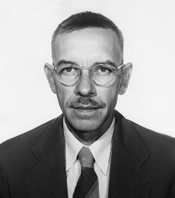Alfred D. Hershey, Ph.D.

Brief Bio
Alfred Day Hershey was born on December 4, 1908, in Owosso, Michigan. He attended Michigan State College, where he earned his B.S. in 1930 and his Ph.D. in bacteriology in 1934. His doctoral dissertation examined the chemical makeup of Brucella, the bacterium responsible for brucellosis. After completing his degree, Hershey accepted a position as an instructor of bacteriology and immunology at Washington University School of Medicine in St. Louis, where he worked closely with department head Jacques Bronfenbrenner (AAI '20, president 1942–46). Since the early 1920s, Bronfenbrenner had focused his research on the physical and lysogenic properties of bacteriophages, and he encouraged his new faculty member to begin studying the viruses. During the late 1930s, Hershey and Bronfenbrenner studied the growth of bacterial cultures, but his own experiments in the early 1940s focused on the phage-antiphage immunologic reaction and other factors that influenced phage infectivity. Looking back over them 60 years later, Stahl wrote that these studies "appear original, thoughtful, and quantitative, especially those on the use of phage inactivation to permit the study of the antigen-antibody reaction at 'infinite' dilution of antigen."
In late January 1943, Delbrück invited Hershey to Nashville to discuss his phage experiments with him and his close friend Luria. Together, the three formed the nucleus of the "phage group," an informal network of the growing number of scientists devoted to studying the bacteriophage. In 1946, Hershey and Delbrück, working independently, found that different strains of bacteriophage can exchange genetic material when both have infected the same bacterial cell, creating a bacteriophage that is a hybrid of the two, a process Hershey referred to as genetic recombination. By the mid-1940s, Hershey's research with bacteriophage began to shift away from immunology to genetics, biochemistry, and molecular biology.
In 1950, Hershey became a staff member in the Department of Genetics of the Carnegie Institution of Washington at the Cold Spring Harbor Laboratory on Long Island. It was here that he and Chase conducted the blender experiment. In 1962, Hershey was named head of the Genetics Research Unit at Cold Spring Harbor, a position he held until his retirement in 1972.
Hershey died on May 22, 1997, in Syosset, New York, at the age of 88.
Nobel Prize in Physiology or Medicine
1969 Nobel Prize in Physiology or Medicine with Max Delbrück and
Salvador E. Luria (AAI '58) “for their discoveries concerning the replication mechanism and the genetic structure of viruses.”
Lasker Award
1958 Albert Lasker Basic Medical Research Award with Gerhard Schramm and Heinz Fraenkel-Conrat “for their part in the discovery of the fundamental role of nucleic acid in the reproduction of viruses and in the transmission of inherited characteristics.”
Click here for more details.
AAI Service History
Joined: 1942
Nobel Prize in Science
Alfred D. Hershey was awarded the 1969 Nobel Prize in Physiology or Medicine jointly with Max Delbrück and Salvador E. Luria (AAI '58) for "their discoveries concerning the replication mechanism and the genetic structure of viruses." As leading figures in the study of viruses that infect bacteria, known as bacteriophage, Hershey, Delbrück, and Luria pioneered the fields of microbiology and genetics. Hershey's unique contribution was the discovery that DNA, and not protein, was the genetic material in bacteriophage, a discovery based on evidence from the legendary "blender experiment" undertaken with Martha Chase in 1952.
Bacteriophages were known to be comprised of DNA and protein, and Hershey wanted to determine which of these components was the heritable material passed on to bacteria to form bacteriophage progeny. To trace each of these components separately, Hershey and Chase first prepared one batch of bacteriophage with radioactive phosphorus to label DNA and another with radioactive sulfur to label protein. They then infected different bacterial batches with each of these labeled bacteriophages. Using a Waring blender to shear off the surface-attached bacteriophage from infected bacteria, they were able to analyze the radioactive content of the bacteria and identify the transferred genetic material.
Infected bacteria contained radioactive phosphorus and were also capable of producing bacteriophage progeny, whereas radioactive sulfur was not associated with the bacterial DNA. These results indicated that DNA was transferred from the bacteriophage to the bacteria and that the genetic material in bacteriophage is DNA. These observations enabled Hershey and Chase to confirm that DNA, and not protein, contained genetic information.
Hershey next turned his attention to understanding the infection cycle of bacteriophage at a molecular level and was the first to detect a unique nucleic acid fraction that was later identified as messenger RNA. The consummate experimenter, Hershey continued to develop new laboratory methods for handling, fractioning, and measuring DNA. "There is nothing more satisfying to me than developing a method," he once told a colleague. "Ideas come and go, but a method lasts."
Hershey was renowned for his ingenuity in the lab and was praised by molecular biologist and geneticist Franklin W. Stahl, among other titans, for being "fearless" in the laboratory and "impeccable" in analysis. Stahl lauded Hershey for his humility and absence of pretension: "He talked to the reader, explaining things as he saw them, but never letting us forget that he was transmitting provisional understanding. We got no free rides, no revealed truths, no invitation to surrender our own judgment. And we could never skim, since every word was important. I think this style reflected his verbal reticence, which in turn mirrored his modesty."
Awards and Honors
Institutional/Biographical Links